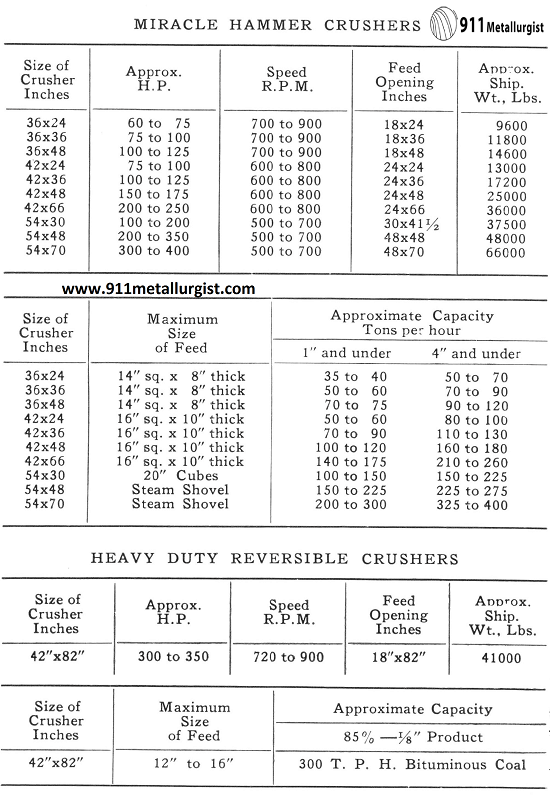Operational Characteristics: The method of operation has a considerable effect upon the nature of the product. When minimum fines are a requirement, the hammer mill should always he operated in closed circuit with a screen, or screens; the circulating load should be fairly high; speed should be as low as is consistent with physical structure of the material; and grates should be widely spaced or, in some cases, dispensed with entirely.
Although the hammer mill usually produces a relatively high percentage of fine material, it does not usually make an inordinately high proportion of what are commonly designated as “extreme-fines” unless the mill is adjusted and operated with that end in view. 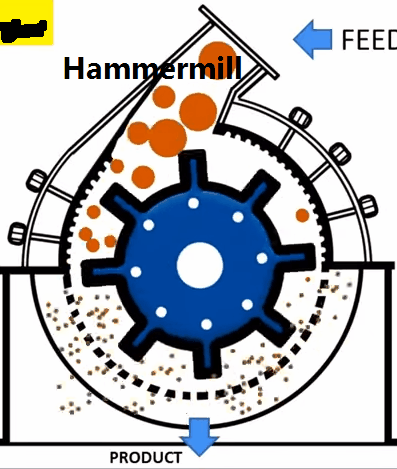 For example, if we are turning out a 0.75″ (top size) product in one of these machines we will usually find the proportion of particles in the range between 0.25″ and about 30 or 40 mesh to be high, as compared to the product of pressure-type crushers; but unless the material is very friable and the natural grain size very fine the percentage of minus 100- and 200-mesh particles will usually compare quite closely. Here again we have the fact that the impact effect falls off directly with the particle mass, to explain an apparent inconsistency.
For example, if we are turning out a 0.75″ (top size) product in one of these machines we will usually find the proportion of particles in the range between 0.25″ and about 30 or 40 mesh to be high, as compared to the product of pressure-type crushers; but unless the material is very friable and the natural grain size very fine the percentage of minus 100- and 200-mesh particles will usually compare quite closely. Here again we have the fact that the impact effect falls off directly with the particle mass, to explain an apparent inconsistency.
It is easy to understand why the hammermill should turn out a cubical product. The impact action is ideally adapted for breaking flat or elongated spalls. If the material contains numerous parallel cleavage planes the initial blows delivered by the hammers may knock off flat spalls; but the chances are very much against such spalls getting out of the machine before they are struck several times and broken into particles of more cubical proportions.
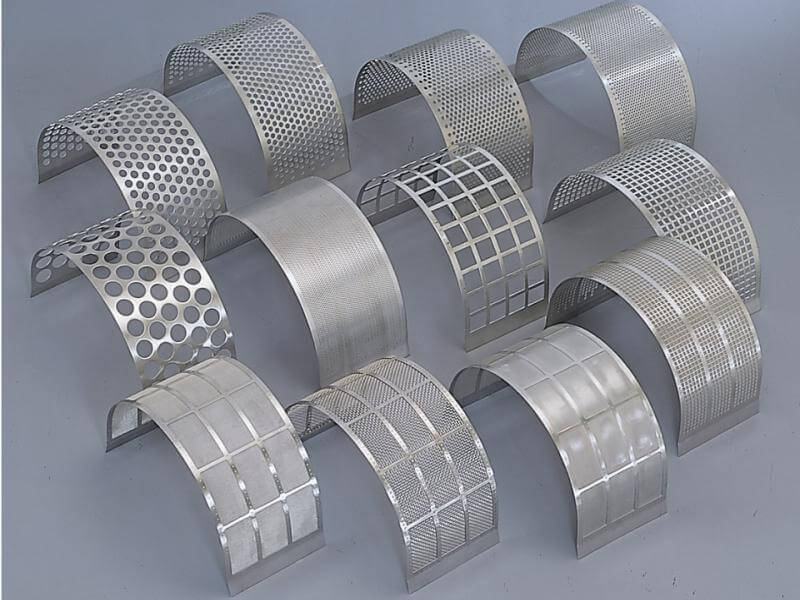
This is especially true of machines which have a long impact zone ahead of the grate section, as no particle can possibly be discharged until it has passed through this impact section, where it will almost certainly be struck several blows.
Hammer Mill Reduction Ratio
Hammermills are capable of accomplishing: reductions very much greater than any other type of crushing equipment. It is possible, though not always economical, to make reductions as high as 20:1 in open circuit, and to double this performance in closed circuit. As in any other type of crusher, low reduction ratios are indicated where a low percentage of fines is desirable.
Hammer Mill Applications
Time was when all hammermills came under the generic title of “pulverizer” which was quite appropriate as it aptly described the kind of work to which they were, in those days, almost exclusively applied. This duty consisted largely of such work as pulverizing limestone for various purposes: agricultural flour, glass sand, tube mill feed, and so forth. This was work for which the hammermill was and still pre-eminently well suited, and large numbers of them are used today for such service. The field has however in recent years been greatly expanded. The following list, while not comprehensive, includes some of the more important present day applications: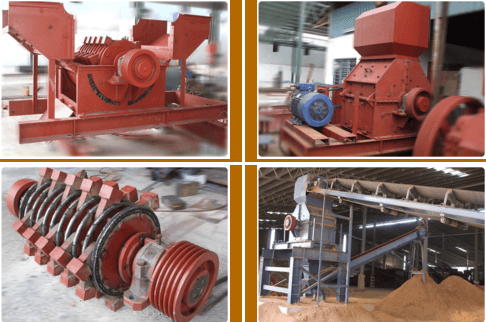
- Agricultural limestone.
- Grits.
- Glass sand, or flour.
- Raw materials for cement manufacture.
- Coal and coke crushing.
- Preparation of tube mill feed on several non-abrasive materials.
- Gypsum crushing and pulverizing.
- Shale crushing.
- Grinding hay and grains for chopped feeds.
- Manufactured sand for concrete aggregates.
- Commercial crushed stone production.
- Dry crushing of ores for dry or wet concentration.
- Concrete recycling
- Marble counter-top recycling
- eScrap Electrics metal recycling
Not all of the uses listed can, in our opinion, be considered as economically sound applications for the hammermill. This machine cannot be expected to operate economically on abrasive feed, and it should not be so applied unless there are strong reasons for doing so. Generally this narrows itself down to cases where no other type of crusher will deliver the type of product required; occasionally the high reduction ratio of which they are capable will dictate their use in temporary jobs where the cost of a two-stage set-up of more economical operating characteristics would more than offset the cost of the single hammermill plus the expected cost of maintenance. A case in point to illustrate the latter condition is that of pilot plant testing in the development of new mining properties.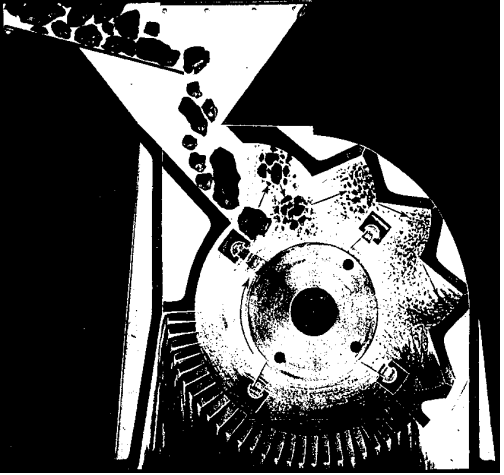
Sectional view shows how material is broken down in one type of hammermill. Material is fed to an inclined plate which is fastened to the hopper over the feed opening. This plate is so arranged that the material is evenly distributed and fed uniformly to the mill. The rapidly revolving hammers (see arrows indicating direction of rotation) strike the material a succession of heavy blows, shattering it and throwing it violently against the first involute breaker plate. Striking this plate with great farce, the material is again shattered and, as it rebounds, it is struck again and carried ta a second involute breaker plate from where it again rebounds and so on through five stages. The pulverized product passes out through grate bars In the bottom of the machine
Hammer Mill Operating Principle
We have never subscribed to the idea that the hammermill is suited to the primary breaking of shovel-loaded, quarry-run, or ROM mine-run rock and ore. Even though the material be non-abrasive and quite friable there are other machines which are better fitted for such work. Nor do we believe that the hammermill has a place in any of the stages of a plant intended for the production of commercial crushed stone unless the production of a high percentage of fines is not objectionable; a rather rare condition for operations of this character.
These legitimate restrictions still leave quite a broad field for this ma-chine, and it is probable that more applications will crop up from time to time as our chemical industries grow.
Examination of cement plant flowsheets, discloses that, at that time, only six of these plants employed hammermills, and two of these were used in the shale crushing department. Today the hammermill is widely accepted as a secondary or tertiary crusher in cement plants throughout the country; and there are isolated instances where they perform the primary breaking as well.
The Pulverator/Impactor/Hammermill/Impact-Crusher was successfully applied to the production of manufactured sand for concrete aggregates used in the construction of a large dam in one of the eastern states. This application was made after crushing rolls had been tried and discarded because their product ran so heavily to flat spalls that a workable concrete could not be made with it. We mention this case as being indicative of the ability of the hammermill to cube material, even though the rock’s physical structure is conducive to spalling or flaking. Subsequent installations for the same purpose have been equally successful.
https://www.911metallurgist.com/blog/hammer-mill-working-principle[/fusion_builder_column][/fusion_builder_row][/fusion_builder_container]
Hammer Mill Crusher
The Dixie (Non-Clog) Hammer Mill Crusher differs from all other hammermills in that its breaker plate, instead of being stationary, is a continuously moving belt of manganese steel links. The feed thrown into the hopper is carried by a positive mechanical feed to the hammer-points and then on through the grates.
The most important results from the installation of the Dixie (Non-Clog) Hammermill are the uniform high quality of the product and the enormous crushing power, which, with reduction range of this mill, eliminate the necessity of using several units to obtain the necessary production.
The Dixie (Non-Clog) Hammermill is manufactured in fourteen different sizes, adapted to reduction of any materials containing moisture without clogging. Due to various adjustments this equipment is capable of crushing to a minimum of fines or pulverizing to a maximum of fines. The adjusting features are exclusive Dixie patents.
The non-clog moving breaker plate is a patented feature found only in Dixie Hammermills, positively eliminating all troubles and loss of production from wet or sticky materials that would continually clog any other type crusher or pulverizer. It is capable of crushing potash, salt, mica, limestone, gypsum, coal, or any similar soft material not exceeding 4 on the Mohs scale of hardness.
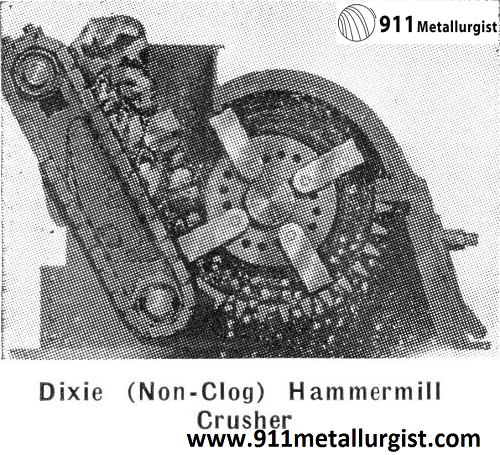
Hammer Mill Capacity Table
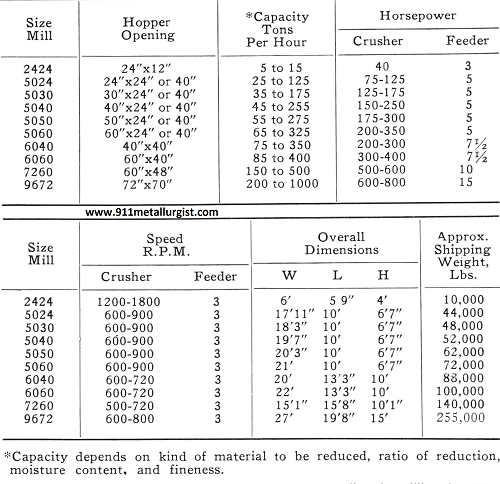
Hammer Crusher
The Jeffrey Miracle Hammer Crusher is designed for the reduction of large pieces and large capacities of limestone, shale, slag, and cement rock. The larger sizes are built to take steam shovel size limestone, crushing it into pieces 1″, 2″, 3″, or 4″ and under, in one operation, the one unit doing the work ordinarily done by two or more of other types of crushers. This enables large reduction of limestone and other materials to a uniform size with minimum initial and production costs. All parts are extra heavy to withstand heavy, continuous service. The Miracle Hammer Crushers are supplied with either heavy cast iron frames or with armor-plate steel frames with manganese steel liners. These crushers are provided with a hinged breaker plate easily adjustable to compensate for wear, as well as giving easy access to working parts. The large, heavy duty crushers are frequently used in such industries as carbide, chemical and cement as a primary machine where large capacities and cubical products are desired.
The Jeffrey Heavy Duty Reversible Hammer Crusher is designed especially for reducing bituminous coal down to a product of 85% minus 1/8″, at large capacities, for coking purposes. These machines are also adaptable to the reduction of abrasive materials since they are symmetrical about the vertical center line and when one corner of the hammers become worn, it is only necessary to reverse the direction of the rotor in order to use the opposite unused faces of the hammers. The frame is made of heavy welded plate steel equipped with removable manganese liners and provided with vertical hinged breaker plates to compensate for the wear on breaker plate liners.
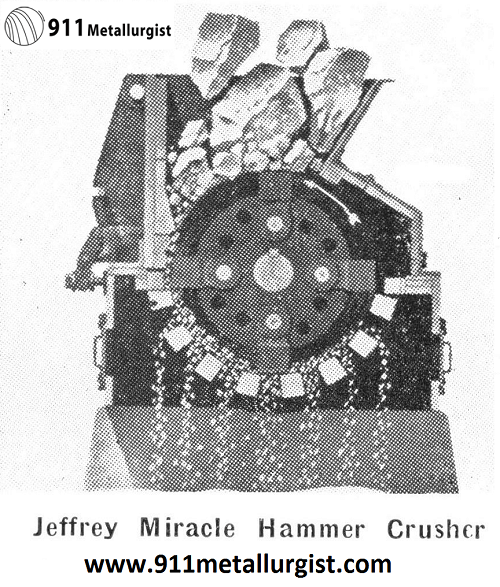
Hammer Mill Crusher Capacity Table
